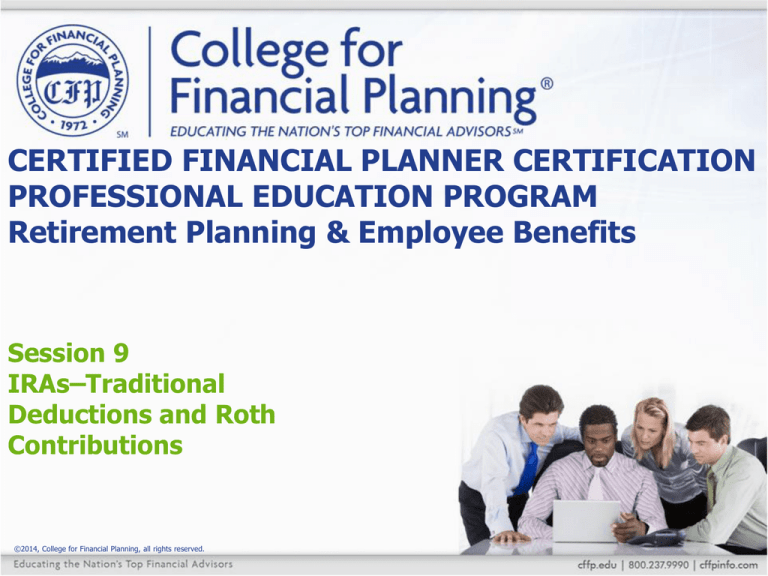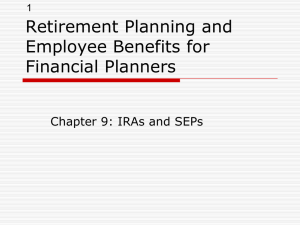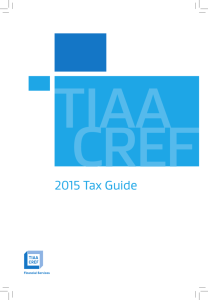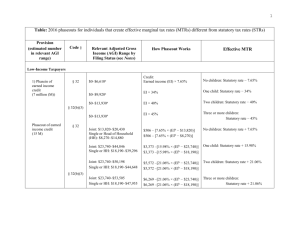
CERTIFIED FINANCIAL PLANNER CERTIFICATION
PROFESSIONAL EDUCATION PROGRAM
Retirement Planning & Employee Benefits
Session 9
IRAs–Traditional
Deductions and Roth
Contributions
©2014, College for Financial Planning, all rights reserved.
Session Details
Module
5
Chapter(s) 1, 3
LOs
5-2
5-4
Describe the basic characteristics of traditional
IRAs, and analyze a situation to calculate the
amount of an IRA contribution that is
deductible.
Describe the basic characteristics of Roth
IRAs, and analyze a situation to calculate the
eligible contribution amount.
9-2
IRA Statutory Requirements
• Eligibility: Compensation (earned income, alimony) and
•
•
•
•
must be under age 70½ (no age limit on Roth IRAs)
Contribution limit: 100% of earned income up to $5,500
(spousal IRAs allowed), $1,000 age 50 catch-up
Contribution deadline: April 15—no extensions
Taxation: Earnings are tax-deferred
Minimum: If an amount greater
than $0, but less than $200 is
deductible, then a $200 minimum
deductible contribution is allowed
9-3
IRA Statutory Requirements
•
•
•
•
•
Fully vested
No life insurance or collectibles
No loans
RMDs starting at age 70½
(not for Roth IRAs)
6% penalty tax on excess
contributions
9-4
IRA Deductibility Active Participant Status
An employee is an active participant in a defined contribution plan if,
during the taxable year, the employee received any annual additions to
his/her account.
Employer
Contribution
or
Employee Contribution
(either voluntary or mandatory)
or
Forfeiture
To one of the following plans:
•
•
•
•
All qualified plans
Tax-sheltered annuity (TSA) under §403(b)
Simplified employee pension (SEP) & SIMPLE plans
Government pension plan
An employee is an active participant in a defined benefit plan if the
employee is eligible to participate in the plan and has not opted out.
(Note that investment earnings do not affect active participant status.)
9-5
Traditional IRA Deduction Phaseout Amounts (2014)
Single Taxpayer
Not an Active
Participant
No Phaseout
Active
Participant
$60,000$70,000
Married Taxpayers Filing Jointly
Neither is an
Active Participant
One Active
Participant
Both Active
Participants
No Phaseout
Active
participant:
$96,000$116,000
$96,000$116,000
Other Spouse:
$181,000$191,000
9-6
Calculation of Deductible IRA Contribution
1. Determine the deductible percentage
2. Multiply by the maximum contribution amount
3. The result is the maximum dollar amount that
can be deducted (rounded up to the next $10)
Example: Single, Modified AGI $66,000
$70,000 $66,000
.4 $5,500 $2,200
$10,000
9-7
Calculation of Deductible IRA Contribution (1)
1. Determine the deductible percentage
2. Multiply by the maximum contribution amount
3. The result is the maximum dollar amount that
can be deducted (rounded up to the next $10)
Example: Married/Joint active participant,
Modified AGI of $98,316
$116,000 $98,316
$20,000
.8842 $5,500 $4,863.10
$4,863.10 rounded up to nearest $10 $4,870.00
9-8
Calculation of Deductible IRA Contribution (2)
• Same as previous scenario, except individual is
•
•
•
age 50 or older
.8842 x $6,500 = $5,747.30
Round up to nearest $10 = $5,750 deductible
amount
Balance of $6,500 – $5,750 = $750
can be a nondeductible IRA contribution
9-9
Roth IRA Contribution 2014 Phaseouts
Filing Status
Phaseout*
Single
$114,000–$129,000
Married, filing jointly
$181,000–$191,000
* Without regard to “active participant” status
9-10
Multiple Choice Question 1
Allen Baker, a single 40-year-old taxpayer with an AGI
of $68,800, is covered by his employer’s profit
sharing/401(k) plan. During the plan year, no employer
contribution was made and Allen did not make any
salary reduction contributions to the 401(k) portion of
the plan. Allen’s account balance increased by $120;
this was attributable to investment earnings of $80 and
forfeitures of $40.
If he contributes $5,500 to his IRA, what is the amount
of his allowable IRA deduction?
a. $0
b. $200
c. $660
d. $5,500
9-11
Multiple Choice Question 2
Assume the facts above except that Allen is
married, his spouse is not an active participant,
they file jointly, and their AGI is $107,000.
What is the amount of their IRA deduction?
a. $0
b. $900
c. $5,500
d. $7,980
e. $11,000
9-12
Multiple Choice Question 3
Ken and Barbie file jointly. Both work, and their combined
AGI is $106,000. This year, Ken’s profit sharing account
earned over $5,000, but the company made no contributions
and there were no forfeitures. Barbie declined to participate
in her company’s defined benefit plan in July because she
wants to contribute to and manage her own retirement
money. (Her benefit at age 65 under the plan was $240 per
month.)
How much of their $11,000 contribution can they deduct?
a. $0
b. $5,500
c. $8,250
d. $11,000
9-13
Multiple Choice Question 4
Lucy received a $1,200 profit sharing
contribution this year. Lucy and George are
married, filing jointly. George is an artist who
had no earnings this year. Their combined AGI
for this year is $109,000.
How much of their $11,000 IRA contribution
can they deduct?
a. $0
b. $5,500
c. $7,430
d. $11,000
9-14
Multiple Choice Question 5
Sally and Joe are married, filing jointly. Their
combined AGI is $146,000. They are both
active participants in their employers’ plans.
After making the maximum qualified plan
contributions, they wish to make contributions
to their Roth IRAs.
How much can they contribute to their Roth
IRAs?
a. $0
b. $1,000
c. $5,500
d. $11,000
9-15
Multiple Choice Question 6
Jerry’s AGI totals $121,000 this year. He is
single. What is the maximum amount he can
contribute to his Roth IRA this year?
a. $0
b. $1,000
c. $2,940
d. $5,500
9-16
CERTIFIED FINANCIAL PLANNER CERTIFICATION
PROFESSIONAL EDUCATION PROGRAM
Retirement Planning & Employee Benefits
Session 9
End of Slides
©2014, College for Financial Planning, all rights reserved.










